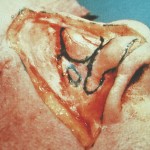
Think of your nose as a house. The shingles are the overlying skin, the framework and timbers are the cartilage and bone, and the drywall the nasal lining. The support that lies underneath the highest roof angle is the septum. (cartilage) What makes anyone’s nose look the way it does, like a house, is a reflection of how the framework is structured and the roof (skin) that drapes over this framework. As plastic surgeons we think of the nose as 4 areas, the upper 1/3 which is bone, the middle 1/3 known as the middle vault which is all cartilage which is straight, and the lower 1/3 or the tip of the nose which is a combination of scroll-shaped cartilages that come together over the septum and is what gives everyone their unique tip shape. (which is the most different between any two people) The fourth area is the skin, which dependent upon its thickness, can show the underlying framework well if it is thin but can hide much of it if it is thick.
When we alter the nose we are changing the way the framework (bone and cartilage) is joined together and is shaped. This could be taking down the height of the roof in one area (that bump on your upper nose), reshaping the tip of the nose (by changing the shape of the scrolled cartilages, breaking the bone along the bridge to narrow the nose (collapsing the walls), or in some cases adding to the roof line with implants or cartilage to raise the height of the roof line.
Due to the complexity of how all of these framework structures come together, most rhinoplasties today are done ‘open’. While this used to be a controversial area (what was known as the most contested 6 millimeters of skin on the body), it is now accepted to produce the best results in most nose surgeries. All that this means is the skin is lifted off of the tip of the nose so all the framework structures can be seen. To no surprise, you can shape better what you can see better. This only leaves a nearly imperceptible scar at the middle of the skin between your nostrils. (known as the columella) This is a very small price to pay for a better rhinoplasty result!
Dr Barry Eppley
Indianapolis, Indiana


